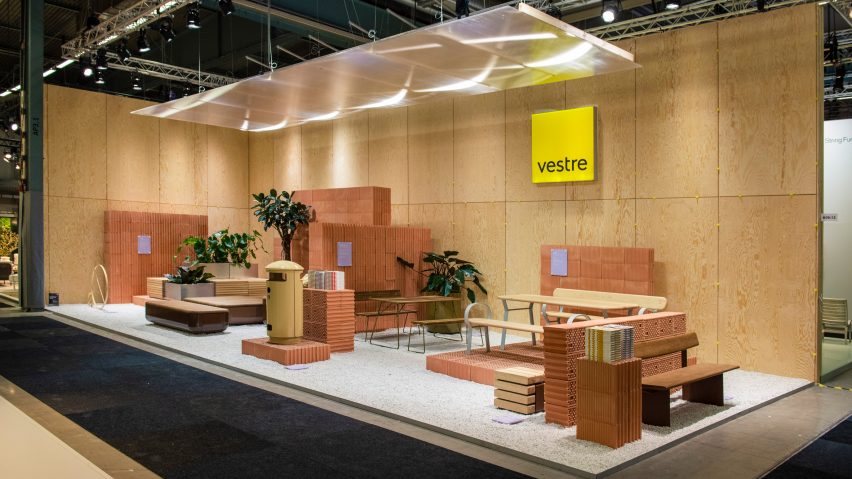Norwegian urban furniture brand Vestre has won the best stand award at Stockholm Furniture & Light Fair for an installation featuring re-usable materials and information about the carbon footprint of every product.
Designed by Note Design Studio, the stand features walls clad in uncut sheets of plywood, stands built up of uncemented bricks and a floor of stone chips.
After the fair, the materials will be stored for future use rather than thrown away."We've chosen to work with unprocessed natural materials where wastage is minimal," said Johannes Karlström of Note Design Studio, which also designed a recyclable stand for flooring brand Tarkett at the same fair.
"The idea was to create a beautiful backdrop that is in harmony with the design of Vestre's products, while minimising the amount of waste when the stand is dismantled after the trade show closes," he added.
"The stand is made of natural materials such as wood, bricks and stone," added Note Design Studio's Daniel Heckscher. "Everything is fully recyclable and reusable. It’s modular in the sense that the wood panels are demountable and not screwed or glued."
Heckscher added that the studio hopes that just five per cent of all materials used to build the stand will be wasted.
A display board next to each of Vestre's products – which include outdoor benches, tables and planters – informs visitors of the carbon emissions generated during its manufacture.
A new version of the Folk bench designed by Swedish studio Front, for example, has a carbon footprint of 3.75kg of carbon dioxide per year, assuming the product remains in use for 30 years.
The table from the same range has an annual footprint of 1.09kg of carbon dioxide.
"This stand takes the current concern for sustainability to a new level," said the judges of the best stand award.
"Each element of the display can be reused while the brand has calculated the carbon footprint of every product."
Jan Christian Vestre, the firm's CEO, said he believes his company is the first furniture brand in the world to calculate and publish carbon information on its product range.
"We're doing it because we want to be really open and transparent," said Vestre. "I would like to say that clients are actually demanding it, but they aren't yet."
He added: "We hope this can encourage more companies to do the same, so we can start a debate about how we manufacture things, the resources we use and how long products last."
The company uses the Life-cycle Assessment (LCA) methodology to establish the amount of carbon released during the manufacturing process. To help calculate this, suppliers are asked to provide Environmental Product Declarations (EPDs), which set out the environmental impact of their products.
Vestre strives to reduce the impact of its manufacturing process, choosing materials with the lowest carbon intensity, investing in its own renewable energy sources and ensuring supply chains are as short as possible to minimise transportation emissions. It has so far achieved nine of the United Nations' 17 Sustainable Development Goals.
All Vestre's products come with a lifetime guarantee. "We make products that last really long, said Vestre, who runs the family-owned company. "If they can live forever, we can reduce their energy consumption a lot. "
The best stand award is given each year by a jury of international editors. This year's Editors' Choice jury consisted of Dezeen founder Marcus Fairs, Yatzer founder Costas Voyatzis and Yellowtrace founder Dana Tomic Hughes.
The best new product award went to the Roadie bench by Massproductions while the rising star award was won by English designer Lucas Power.

